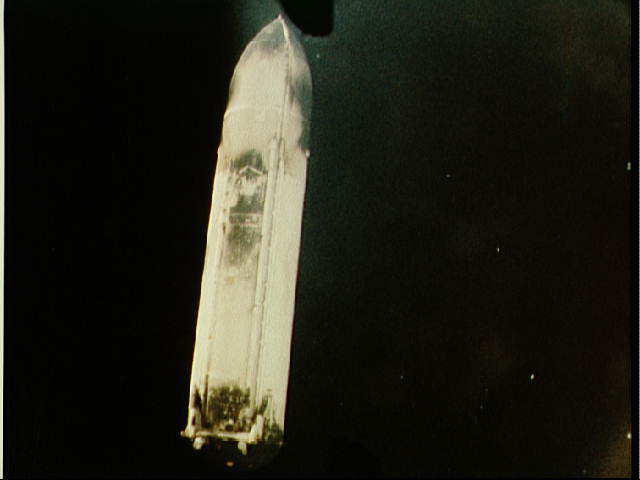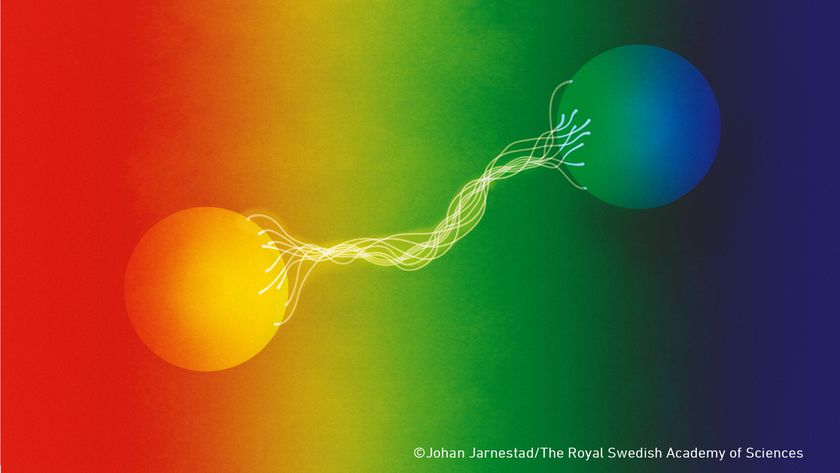Columbia’s White External Fuel Tanks

Many SPACE.comreaders have written letters asking about the white external fuel tanks thatfed NASA's first two orbiter test flights - STS-1and STS-2 - and whether the paint job added any additional protection againstthe type of foam shedding that led to the 2003 Columbia accident.
JohnChapman, NASA's external tank project manager at the Marshall Space FlightCenter (MSFC) in Huntsville, Alabama, said the white paint was initially addedto protect shuttle fuel tanks from the damaging effects of exposure toultraviolet rays during extended periods on the launch pad.
While testswere unfinished as NASA prepared STS-1 for its maiden flight, engineers paintedthe first two tanks to be on the safe side, Chapman said.
"Becauseyou just don't go up to the external tank on the pad with a can of paint and aroller," Chapman told SPACE.com, adding that he, former shuttle tankproject manager Sandy Coleman and Kennedy Space Center (KSC) director JimKennedy watched Columbia's April 12, 1981 launchdebut from the roof of a Winnebago the trio had driven to KSC with threeother coworkers from MSFC.
Subsequenttests found that the paint wasn't vital for shuttle launches and it wasabandoned to free up weight - about 600 pounds (272 kilograms) - for additionalpayload, NASA officials said.'
The paintalso did not prevent foam from popping free of Columbia's fuel tank during itsfirst two launches, Chapman added.
Followingthe Feb. 1, 2003 loss of Columbia during reentry, which investigators found wasdue to heat shield damage caused by tank foam insulation debris at launch, NASArevisited the white paint approach, as well as a myriad other schemes to reducefoam shedding.
Get the Space.com Newsletter
Breaking space news, the latest updates on rocket launches, skywatching events and more!
But addingadditional protection measures, such as a nylon covering or chicken wire mesh,could not only add another debris source during launch, but also lead to largerpieces pulling free from anchored spots, Chapman said.
"Thebiggest thing for us would be to make sure that anything we do doesn't causemore harm than good," Chapman said.
Since the2003 Columbia accident - and NASA's subsequent July-August 2005 STS-114 return to flight missionin which unacceptablylarge chunks of foam were also shed during launch - tank engineers havefocused on reducing the amount of foam insulation on future tanks.
Engineersare also replacing a set of enginecut-off sensors inside the next tank to fly, and preparing for large-scalewind tunnel tests to evaluate the removal of a largefoam ramp that shed unacceptably large pieces of debris during the STS-114flight.
"We do alot of subscale wind tunnel tests, but this will be a closer to a full-sizetest," Chapman said of the upcoming checks.
The windtunnel tests will aid NASA's second return to flight mission - STS-121aboardthe Discovery orbiter - slated to launch no earlier than July 1.
- Faulty Fuel Tank Sensors Prompt Launch Delay for NASA's Next Shuttle Mission
- Next Shuttle Fuel Tank to Fly Arrives at NASA Spaceport
- Return to Flight: NASA's Road to STS-121
- Fixing NASA: Returning to Flight with STS-114
- Columbia Accident Special Report
Join our Space Forums to keep talking space on the latest missions, night sky and more! And if you have a news tip, correction or comment, let us know at: community@space.com.

Tariq is the Editor-in-Chief of Space.com and joined the team in 2001, first as an intern and staff writer, and later as an editor. He covers human spaceflight, exploration and space science, as well as skywatching and entertainment. He became Space.com's Managing Editor in 2009 and Editor-in-Chief in 2019. Before joining Space.com, Tariq was a staff reporter for The Los Angeles Times covering education and city beats in La Habra, Fullerton and Huntington Beach. In October 2022, Tariq received the Harry Kolcum Award for excellence in space reporting from the National Space Club Florida Committee. He is also an Eagle Scout (yes, he has the Space Exploration merit badge) and went to Space Camp four times as a kid and a fifth time as an adult. He has journalism degrees from the University of Southern California and New York University. You can find Tariq at Space.com and as the co-host to the This Week In Space podcast with space historian Rod Pyle on the TWiT network. To see his latest project, you can follow Tariq on Twitter @tariqjmalik.











